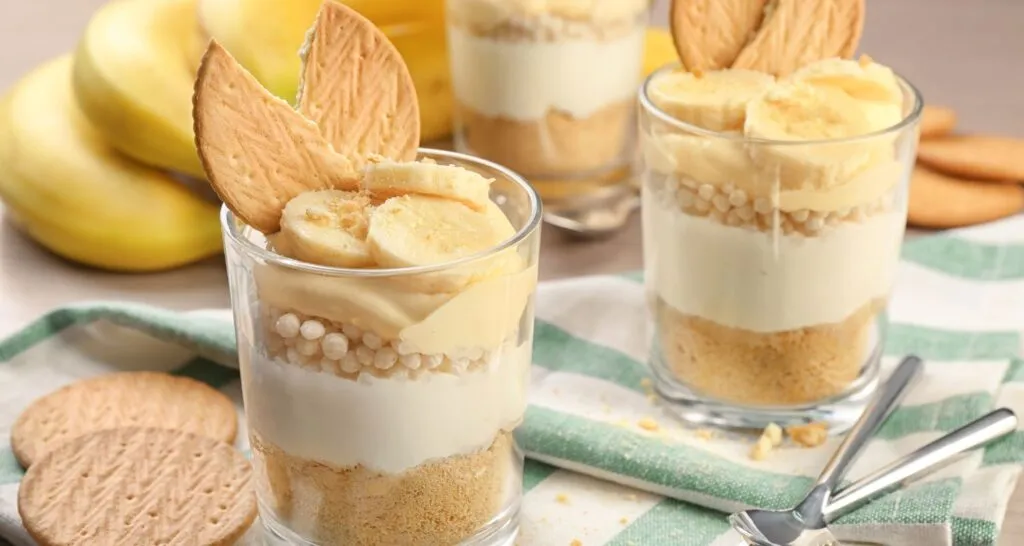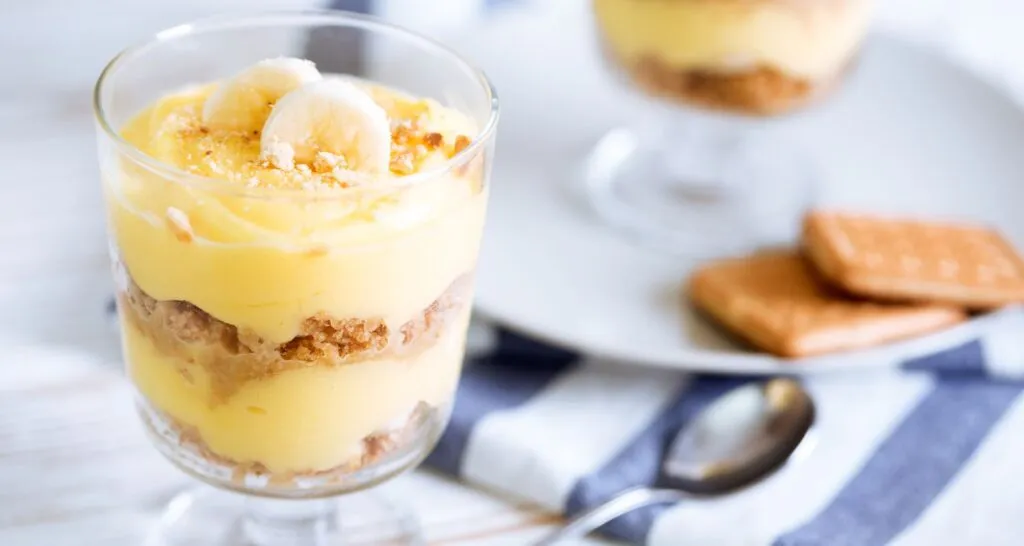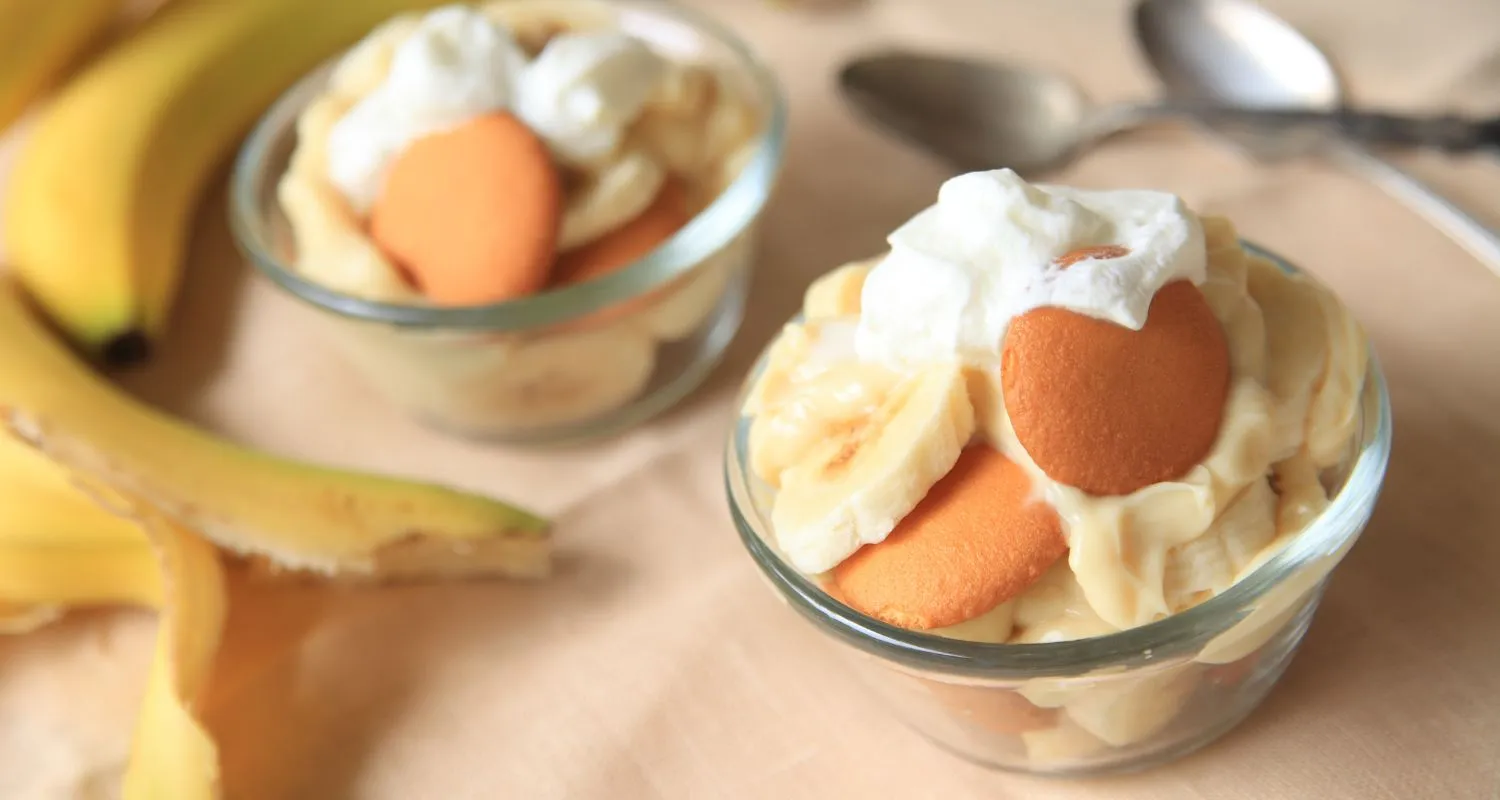Diving into the world of desserts, particularly banana pudding, unfolds a delicious blend of taste and tradition. This article peels back the layers to reveal not just the creamy delight that banana pudding offers but also its caloric content. Whether you’re a health enthusiast, a culinary explorer, or simply someone with a sweet tooth, understanding the caloric makeup of banana pudding is crucial. It’s about balancing the scales between indulgence and health. So, let’s embark on this flavorful journey, exploring everything from the history of banana pudding to tips for making it healthier. Buckle up; it’s going to be a sweet ride!
Understanding Banana Pudding
Banana pudding, a dessert as classic as it is comforting, has roots that run deep in culinary history. Its creamy texture and rich flavor have made it a favorite across generations. But what exactly goes into this beloved dish, and more importantly, how does it fit into our daily caloric intake?
A Brief History of Banana Pudding
Banana pudding’s journey began in the United States, though its exact origins are a bit murky. It emerged as a popular dish in the South, where it quickly became a staple at gatherings and meals. The combination of ripe bananas, creamy pudding, and crisp vanilla wafers creates a dessert that’s both simple and utterly divine.
Why Calories Matter
In today’s health-conscious world, calories have become a focal point of dietary discussions. They’re the energy currency of our bodies, fueling everything from basic bodily functions to intense workouts. But, as with any currency, balance is key. Too many calories, especially from desserts like banana pudding, can lead to weight gain and health issues. Hence, understanding the caloric content of banana pudding is crucial for anyone aiming to enjoy this dessert responsibly.
Stay tuned as we delve deeper into the nutritional landscape of banana pudding, exploring its caloric content, the impact of various recipes, and how to enjoy it without overindulging. It’s not just about counting calories; it’s about making every calorie count.
Nutritional Breakdown
When it comes to banana pudding, its deliciousness is undeniable. But, let’s peel back the layers and look at what’s inside. Knowing the nutritional facts can help us enjoy this dessert without tipping the scales.

The Caloric Content of Banana Pudding
The number of calories in banana pudding can vary widely. It largely depends on the ingredients used. A classic serving might pack anywhere from 200 to 400 calories. Yes, that’s quite the range! The key players in calorie count are sugar, whole milk, and, of course, the vanilla wafers.
Factors Influencing Calorie Count
The recipe plays a huge role here. Homemade versions, where you control the ingredients, can be lighter. For instance, opting for low-fat milk or a sugar substitute can trim down the calories. On the other hand, store-bought or restaurant servings might lean towards the higher end of the calorie spectrum.
Average Calorie Range in Homemade and Store-bought Banana Pudding
Homemade banana pudding offers a spectrum of calorie counts. A lighter version might hover around 200 calories per serving. But, add in full-fat milk, real sugar, and a generous layer of wafers, and you’re looking at around 400 calories. Store-bought versions? They tend to sit at the higher end, often because of added sugars and preservatives.
Macronutrients in Banana Pudding (Protein, Carbs, Fats)
Diving deeper, banana pudding is more than just calories. It’s a dance of macronutrients. Carbs come mainly from bananas and wafers, proteins from milk, and fats from dairy used in the pudding. Each serving might offer around 10 grams of fat, 50 grams of carbs, and a modest 5 grams of protein. Remember, these numbers can vary.
Vitamins and Minerals Presence
It’s not all about the macronutrients, though. Bananas bring potassium and vitamin C to the table, while milk adds a dose of calcium and vitamin D. These nutrients contribute to the overall health benefits of the dessert, making it more than just a treat.
The Role of Ingredients in Nutrition
Every ingredient in banana pudding plays a part in its nutritional profile. By swapping some of these key ingredients for healthier alternatives, we can create a dessert that fits into a balanced diet. For example, using almond milk instead of whole milk can reduce fat content, while a sprinkle of cinnamon can add flavor without extra calories.
In conclusion, banana pudding’s nutritional content is as variable as its recipes. By understanding the impact of each ingredient, we can make informed choices that allow us to indulge in this classic dessert without compromising our health goals. So, go ahead, enjoy that spoonful of banana pudding, but let’s make it a mindful one.
Dietary Considerations
In the realm of desserts, banana pudding is a chameleon. It can adapt to fit various dietary needs and preferences. Whether you’re watching your waistline, managing your carb intake, or following a dairy-free lifestyle, there’s a version of banana pudding for you.
Banana Pudding for Weight Loss
Yes, you can still enjoy banana pudding while trying to lose weight. The trick is in the substitution. Opt for low-fat milk or a milk alternative like almond or oat milk. These swaps significantly reduce the calorie count. Also, consider using a sugar substitute or reducing the sugar amount. Every little bit helps when you’re counting calories.
Keto-Friendly Banana Pudding Variations
For those on a ketogenic diet, traditional banana pudding might seem off-limits. But fear not! A keto-friendly version is entirely possible. Use a sugar substitute and swap regular milk for a high-fat, low-carb alternative like coconut or almond milk. Instead of traditional wafers, you can use keto-friendly cookies. And, of course, use a minimal amount of bananas or a banana extract to keep the carbs in check.
Vegan and Dairy-Free Alternatives
Veganizing banana pudding is easier than you might think. Plant-based milk and a dairy-free whipped topping are all you need to swap. For the pudding, look for a vegan-friendly mix or make your own using plant-based milk thickened with cornstarch and flavored with vanilla. It’s a simple switch that makes banana pudding accessible to everyone.
Making banana pudding fit into your dietary preferences or needs doesn’t mean sacrificing flavor. With a bit of creativity and some smart swaps, you can enjoy this classic dessert no matter your dietary restrictions. So, go ahead, tweak that recipe, and dive into a bowl of guilt-free banana pudding that aligns with your health goals and dietary preferences.
Recipe Variations and Their Caloric Impact
Exploring the world of banana pudding recipes reveals a delightful spectrum of variations. Each twist on the classic recipe brings its own unique flavor and, importantly, its own caloric footprint. Let’s delve into the traditional, low-calorie, and gourmet versions of this beloved dessert.

Classic vs. Modern Banana Pudding Recipes
The traditional banana pudding recipe is a testament to time-honored simplicity. It typically involves layers of vanilla wafers, slices of ripe bananas, and a rich vanilla custard, all topped with a light meringue or whipped cream. This version, while delicious, is often higher in calories due to the full-fat dairy products and sugar used.
In contrast, modern takes on banana pudding experiment with ingredients to cater to health-conscious audiences. For instance, substituting full-fat milk with almond or skim milk can reduce the calorie count. Similarly, using a sugar substitute or lessening the amount of sugar can make a significant difference in the dessert’s overall caloric impact.
Low-Calorie Banana Pudding Recipes
For those aiming to enjoy banana pudding without overindulging, low-calorie recipes are a godsend. These versions might incorporate Greek yogurt instead of heavy cream, add a dash of natural sweeteners like honey, or use a minimal amount of low-fat vanilla wafers. Such alterations help maintain the essence of banana pudding while keeping the calorie count in check.
Gourmet Banana Pudding Variations
Gourmet versions of banana pudding elevate the dessert to new heights of decadence. Ingredients like bourbon-infused vanilla custard, caramelized bananas, or even a layer of chocolate ganache can transform the simple pudding into a sophisticated treat. While these ingredients add complexity and depth of flavor, they also increase the calorie content. Hence, gourmet variations are best enjoyed as an occasional indulgence.
Tips for Reducing Calories in Banana Pudding
Regardless of the recipe you choose, there are always ways to reduce the caloric impact of banana pudding:
- Swap full-fat dairy products with low-fat or plant-based alternatives.
- Use natural sweeteners or reduce the quantity of sugar.
- Opt for lighter toppings, such as fresh fruit or a dollop of low-fat whipped cream.
Indulging in banana pudding doesn’t have to mean compromising on health. By exploring different recipes and making smart ingredient swaps, you can enjoy this classic dessert in a way that aligns with your dietary goals. Whether you’re whipping up a quick low-calorie version or savoring a gourmet variation for a special occasion, banana pudding remains a versatile and ever-delightful treat.
Making Healthier Choices
Adopting healthier choices when indulging in banana pudding allows you to enjoy this delightful dessert without straying from your wellness goals. It’s all about making small adjustments that add up to a significant reduction in calories and unhealthy fats, without compromising on taste.
Ingredient Substitutions
One of the easiest ways to make banana pudding healthier is by swapping out some traditional ingredients for healthier alternatives:
- Milk: Use skim, almond, or coconut milk instead of whole milk to reduce fat and calorie content.
- Sugar: Opt for natural sweeteners like stevia, monk fruit, or even pureed dates to cut down on refined sugar.
- Wafers: Choose whole grain or low-sugar wafers, or even make your own with almond flour for a lower carb option.
- Toppings: Instead of heavy whipped cream, top your pudding with a light dollop of Greek yogurt or a homemade whipped cream made from chilled coconut milk.
Portion Control
Another key to enjoying banana pudding healthily is portion control. Serving your pudding in smaller dishes can help you enjoy the flavors you love while keeping calorie intake in check. This approach allows for a mindful eating experience, focusing on the enjoyment of each bite.
Mindful Eating Practices
Engaging in mindful eating practices can enhance the enjoyment of banana pudding while ensuring that you don’t overindulge. This means eating slowly, savoring each spoonful, and paying attention to how the dessert makes you feel. By being fully present during the experience, you’re likely to feel satisfied with a smaller portion.
Balancing Indulgence with Activity
Balancing occasional indulgences like banana pudding with regular physical activity is crucial. Enjoying a serving of banana pudding after a day of being active is a reward that won’t derail your health goals. It’s all about finding the right balance that works for your body and lifestyle.
Making healthier choices when it comes to desserts like banana pudding doesn’t have to mean sacrificing flavor or satisfaction. With smart substitutions, portion control, and mindful eating, you can enjoy this classic treat in a way that aligns with your health and wellness goals. Remember, it’s not about depriving yourself but about making informed choices that contribute to a balanced and enjoyable eating experience.
FAQs
Navigating the sweet world of banana pudding often brings up a bunch of questions. Let’s tackle some of the most common queries to ensure your next batch is as delicious as it is informed.
Can I Use Vanilla Wafers Instead?
Absolutely! Vanilla wafers are a classic choice in banana pudding for their sweet, crisp texture. For a healthier twist, consider using whole grain or reduced-sugar wafers. They offer a similar crunch with a bit of a nutritional boost.
How Do You Keep Bananas From Becoming Brown?
Bananas brown quickly once they’re exposed to air due to oxidation. To keep them fresh and appealing in your pudding, make sure they’re fully covered with pudding or a light brush of lemon juice. The acidic environment slows down the browning process.
Can I Substitute Cool Whip for Whipping Cream?
Yes, you can. Cool Whip is a convenient alternative to whipping cream, offering a similar texture and sweetness. It’s also lower in calories, which can help lighten up the dessert. Just be mindful of the slightly different taste and texture it may bring to your banana pudding.
Where Did Banana Pudding Come From?
Banana pudding is a classic Southern dish that has warmed hearts and delighted taste buds for generations. Its exact origins are a bit hazy, but it became widely popular in the United States by the early 20th century. The dessert combines the comforting flavors of vanilla, banana, and cream, often layered with wafers or sponge cake, to create a uniquely American comfort food.
How many calories are in a banana pudding parfait?
A banana pudding parfait typically contains between 200 to 400 calories per serving. This range can vary based on the ingredients used, such as the type of milk, the addition of whipped cream, or the inclusion of sugar substitutes. Therefore, for a healthier option, consider using low-fat milk and minimizing added sugars.
How many calories in a banana?
An average medium-sized banana contains about 105 calories. Bananas are a rich source of fiber, potassium, and vitamin C, making them a nutritious snack option. Interestingly, the calorie content slightly increases as the banana ripens, due to the conversion of starches into sugars.
How many calories are in fruit pudding?
Fruit pudding calories can vary widely, ranging from 100 to 250 calories per serving, depending on the types of fruit and additional ingredients used. For example, using fresh fruits and a base of low-calorie yogurt can keep the calorie count on the lower end. Additionally, opting for natural sweeteners like honey can also impact the overall calorie content.
How many carbs are in a banana pudding cake?
A slice of banana pudding cake typically contains about 50 to 70 grams of carbohydrates. This count includes sugars from the bananas, flour, and any added sweeteners. To reduce the carb content, one could substitute almond flour for traditional flour and use a sugar substitute.
How many calories are in a banana dessert?
The calorie content of banana desserts can vary significantly, generally ranging from 150 to 500 calories per serving. The specific count depends on the dessert type and ingredients. For instance, a banana bread slice might be on the lower end, whereas a banana split could be on the higher end due to added ice cream and toppings.
How many calories are in a bowl of banana custard?
A bowl of banana custard typically contains about 200 to 300 calories. This range can fluctuate based on the type of milk used and the amount of sugar added. Opting for skim milk and reducing sugar can make banana custard a lighter dessert option.
How many calories in a small bowl of banana pudding?
A small bowl of banana pudding can have anywhere from 150 to 250 calories. The key factors affecting calorie content include the use of full-fat versus low-fat milk and the amount of added sugars or sweeteners. For a lighter version, consider using low-fat milk and a minimal amount of added sugar.
How much is a serving of banana pudding?
A standard serving of banana pudding is typically about 1/2 cup, which can range from 100 to 200 calories, depending on the recipe specifics. Adjusting the serving size can be a simple way to manage calorie intake while still enjoying this classic dessert.
Addressing these FAQs not only clears up common confusions but also offers a peek into the versatile world of banana pudding. Whether tweaking the recipe to fit dietary needs or exploring its culinary background, there’s always more to learn and love about this timeless dessert. So, go ahead, whip up your version, and enjoy the sweet satisfaction of banana pudding, your way.
Conclusion
As we wrap up our deep dive into the world of banana pudding, it’s clear that this beloved dessert is more than just a treat. It’s a versatile dish that can fit into various dietary preferences and lifestyles with a little creativity and modification. From its humble origins to its current status as a comfort food staple, banana pudding has proven to be a favorite across generations.
Balancing Enjoyment and Health
The journey through banana pudding’s caloric content, nutritional breakdown, and the impact of different recipes has shown us that indulging in this dessert doesn’t have to come with guilt. By making informed choices about ingredients and portions, we can enjoy banana pudding in a way that complements our health goals.
Making Every Calorie Count
Remember, it’s not just about reducing calories; it’s about making those calories count. Opting for ingredients rich in nutrients, like bananas and low-fat dairy, can enhance the nutritional value of your banana pudding. It’s about finding that sweet spot where taste and health meet.
The Future of Banana Pudding
As dietary trends evolve, so too will banana pudding. With the rise of plant-based diets, keto, and other eating styles, there’s no doubt that creative cooks will continue to reinvent this classic dessert. The essence of banana pudding will remain, even as its form adapts to meet new tastes and nutritional standards.
In the end, banana pudding serves as a reminder of the joys of cooking and eating. It’s a dish that invites experimentation, whether you’re sticking to the traditional recipe or venturing into healthier territory. So, grab your spoon, and let’s make every bite of banana pudding a celebration of flavor, tradition, and wellness.
Thank you for joining me on this flavorful journey through the world of banana pudding. May your dessert bowls always be filled with joy, health, and a generous serving of this timeless treat
